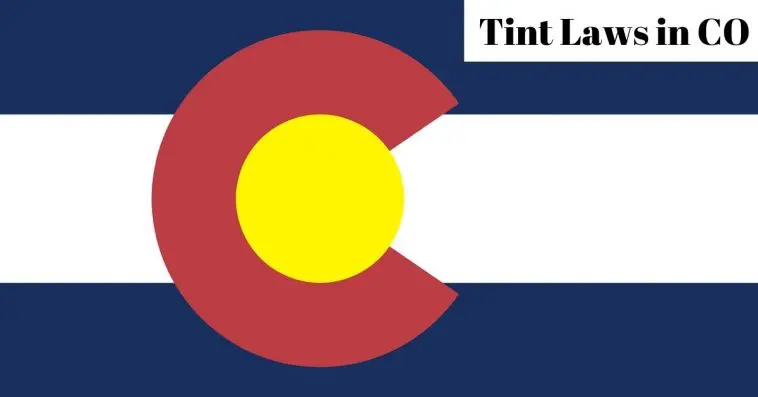If you’re curious about the window tint laws in the State of Colorado, you’ve come to the right place.
The goal of this article will be to show you how to legally tint your windows so you can enjoy comfort while you drive but also avoid tickets or fines from having windows that are too dark.
TABLE OF CONTENTS
Are You Allowed To Have Tinted Windshield And Windows In Colorado?
Yes, you are allowed to have window tinting in the state of Colorado, but there are some caveats.
Before we begin, let’s talk about VLT- it stands for Visible Light Transmission. This refers to the amount of visible light that comes through the glass of your vehicle’s windows.
You can have 27% or more VLT tint on all four side windows, plus the rear window or ANY percent of VLT window tint on the back window and back side window so long as the two front have NO tinting.
Meanwhile, windshields are only allowed to have the top four inches tinted.
What Is The Darkest Tint You Can Legally Get In CO?
At this time, you can have ANY percent of VLT window tint on the back window and back side window so long as the two windows up front have zero tintings.
Otherwise, the limit is 27% on the rear window as well as all four side windows.
Is 20 Tint Illegal In CO?
No, because the limit is 27%, 20% tint is illegal in Colorado.
Can You Get Pulled Over For Tinted Windows In Colorado?
Yes. If the officer suspects that the tints on your windows go beyond the legal limit for the state of Colorado, you may be pulled over. If your tints are amber or red in color, you will be pulled over regardless of the percentage. These colors are not permitted for use.
How Much Is A Tint Ticket in CO?
In Colorado, the penalty for having improperly tinted windows could result in a misdemeanor with a fine ranging from $500 to $5000, or a Class B Traffic Infraction.
However, the fine you are assessed will be dependent on a few factors. For example, if it is your first time being pulled over for such an infraction, the fine may end up being less than someone who has been stopped before for tints.
Some of you might be fortunate enough to simply get a “fix it” ticket, which would require you to simply remove the tints, show an officer you have complied with the ticket, and that would be the end of the matter.
As you can see, the fines are expensive, and leniency is not guaranteed. It’s better to just have your windows professionally treated by someone well versed in Colorado tint law instead of deal with ramifications from the police and courts.
Window Tint Darkness In Colorado
Whether you own a truck, car, SUV, utility van, or something in between, it’s important to know what to expect as you plan to tint your windows.
Passenger vehicles refer to coupes, sedans, station wagons, hatchbacks, and convertibles. It is a vehicle that can carry people but does not include cargo space, a cargo bed, or third-row seats.
Meanwhile, many vehicles fall under the MPV umbrella. These are your pickup trucks, utility vans, minivans, SUVs, RVs, and crossovers. If you can carry over five people, or your vehicle is designed for work purposes or contains a living space, you have yourself an MPV.
See below for tinting regulations when it comes to passenger vehicles and MPVs.
For Passenger Vehicle
- Rear Window: Must let in more than 27% of light
- Back Side Window: Must let in more than 27% of light
- Front Side Window: Must let in more than 27% of light
- Windshield: 70% VLT, non-reflective tint is permitted on the top 4in of the windshield
For MPV (Multi-Purpose Vehicle)
- Rear Window: Must let in more than 27% of light
- Back Side Windows: Must let in more than 27% of light
- Front Side windows: Must let in more than 27% of light
- Windshield: 70% VLT, non-reflective tint is permitted on the top 4in of the windshield
Window Tint Reflection In Colorado
So far, you’ve learned the basics about Colorado window tints; you know what the appropriate percentage is. But what if you would like to install reflective window tints?
These types of tints have some good advantages. For example, glare and heat is reduced inside your vehicle, providing more comfort for you and your passengers.
Reflective window tint makes it so the person looking at the tints on your car sees themselves, but not you or your passengers. You can see out the window, however.
Many people like this for the privacy it gives them. But if the tint is too reflective in nature, it can blind drivers as they come toward you.
But is it legal in Colorado? Read on to find out.
For Passenger Vehicle
- Front Side Window: No mirrored or metallic tints are permitted
- Back Side Window: No mirrored or metallic tints are permitted
For MPV (Multi-Purpose Vehicle)
- Front Side Window: No mirrored or metallic tints are permitted
- Back Side Window: No mirrored or metallic tints are permitted
How Do You Get A Medical Exemption For Window Tint In Colorado?
Medical exams for window tints let you put on tinting that is darker than legally allowed by state law. Each and every state has its own rules and regulations when it comes to dealing with darker tints. Some states do not allow it at all.
Colorado is one of these states. Colorado does not permit medical exemptions for tinted windows.
Conclusion
At first, the tinting laws pertaining to the state of Colorado seem confusing. I hope this article has been a straightforward source for you as you think about tinting your own windows.
Thankfully, Colorado is not a state that disallows tints completely, so you are free to reasonably tint your windows, keep the sun out and the temperature regulated inside your car.
I hope this article has given you the basics of what you need to know about window tinting for Colorado. If you require more information, please check out the CO DMV website.




